Mario Kart: Double Dash!!/Regional Differences
This is a sub-page of Mario Kart: Double Dash!!.
| To do: Item slot lists are different between all three revisions. |
All three retail versions of the game are three days apart from each other before completion, with the European getting completed first on October 3rd, 2003, the North American release second on October 6th, 2003, and the Japanese last on October 9th, 2003. As such, some minor alterations were made in the week following up to the game's end of development.
Contents
GameCube Banner
| Europe / Australia | USA | Japan | |
|---|---|---|---|
| Short titles | Mario Kart: Double Dash ! ! NINTENDO |
MarioKart:DoubleDash NINTENDO |
マリオカート ダブルダッシュ!! NINTENDO |
| Long titles | Mario Kart: Double Dash!! NINTENDO Mario Kart races onto the Nintendo GameCube! 2 riders & twice the thrills! |
Mario Kart: Double Dash!! NINTENDO MarioKart races onto the Nintendo GameCube! 2 riders & twice the thrills! |
マリオカート ダブルダッシュ!! NINTENDO マリオカートがゲームキューブに登場! こんどは2人乗りで大爆走! |
Between the European and North American releases, the short title was altered to read "MarioKart:DoubleDash" without spaces or exclamation marks. The space between "Mario" and "Kart" in the description was also removed. As a result, the European banner is a more accurate translation from the Japanese release.
Video Settings
| Europe / Australia | USA / Japan |
|---|---|
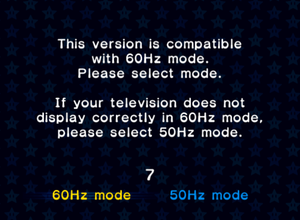
|

|
The European release has an additional screen to switch between 50Hz and 60Hz before starting the game. Alongside this is a seven second countdown before the game automatically picks 50Hz. Since TVs in North American and Japanese regions are by default 60Hz, this screen instead asks to enable progressive scanning (480p) with a nine second countdown if component cables are connected through the GameCube's digital out port.
FMV Intro
| Europe / Australia / USA | Japan |
|---|---|
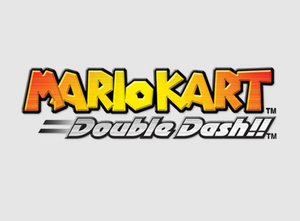
|
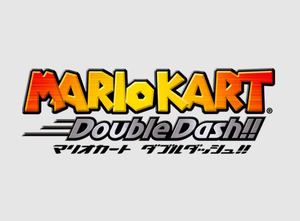
|
The main contents of the FMV is identical in all regions. The only changes are made near the end, where the logo was changed for the Japanese release.
- The Mario Kart portion is a bit more saturated.
- The Double Dash!! portion uses the same font, though with a different thickness, has three stripes instead of two, and has no streak through the letter D.
- The two trademark symbols were simplified to one registered symbol.
- The game's title is on the bottom in Japanese.
Additionally, the European version contains an extra version of this FMV suited for 50Hz displays.
Title Screen
| Europe / Australia / USA | Japan |
|---|---|
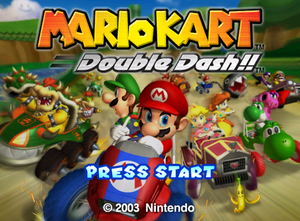
|

|
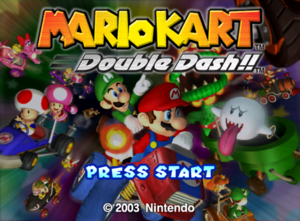
|
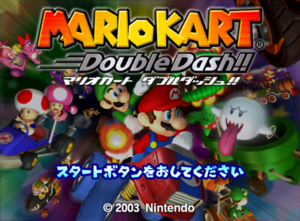
|
- All changes made to the Japanese logo are present on the title screen too, though the Japanese subtitle was changed to white for visibility.
- All text graphics present in the game are, as to be expected, in Japanese.
Character & Kart Select
| Europe / Australia / USA | Japan |
|---|---|
When selecting a character and kart combo, characters have two voice clips; one for getting selected and one confirming the player's selection. In the Japanese release, Birdo has two unique voice clips, with her selection voice clip having her say her Japanese name ("Catherine"). However, since her confirmation voice clip has her saying her English name ("Birdo"), the international releases reused Birdo's confirmation clip to replace her selection voice clip. As a result, Birdo is the only character who has identical voice clips in the international release.
Gameplay
| Europe / Australia / USA | Europe / Australia / Japan |
|---|---|

|
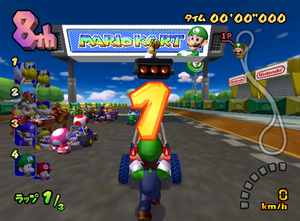
|
The speedometer measures kilometers per hour (km/h) in the Japanese release and miles per hour (mph) in the North American release. For the European release, it depends on the language used, with all other languages except English measuring in kilometers per hour.
Race Results
| Europe / Australia | USA | Japan |
|---|---|---|
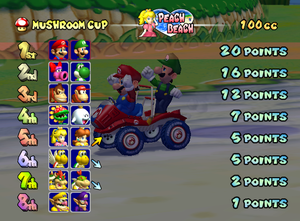
|
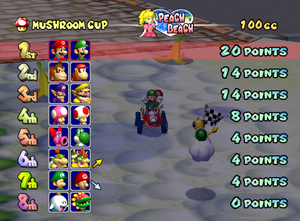
|
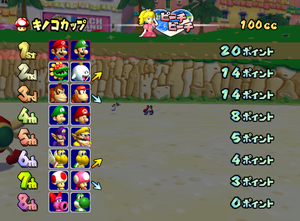
|
| USA | Europe / Australia / Japan | |
|---|---|---|
| ArrowGP1.bti | ||
| ArrowGP3.bti |
The North American release uses much more generic arrows (located in MRAM.arc/race2d.arc/timg) to indicate whether a player has gone up or down in the rankings. In the European and Japanese release, these arrows are more stylized.
LAN Matches
| Europe / Australia | USA | Japan |
|---|---|---|

|
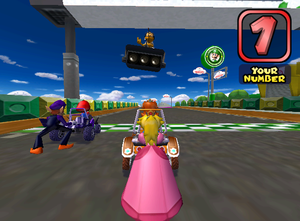
|
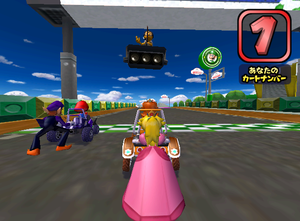
|
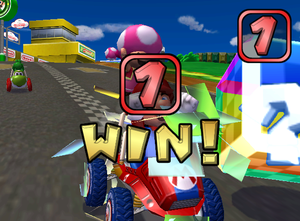
|

|
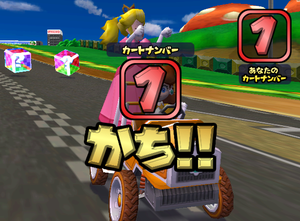
|
LAN matches in the North American and Japanese releases have additional text to clearly define what the player's LAN position is. This text (and its graphic files) are not present in the European release.
Ending
| 50Hz | 60Hz |
|---|---|
To prevent the ending track from finishing too early when playing in 50Hz, a version of the ending theme made to play during 50Hz is included exclusively in the European release. A few differences are of note.
- The entire track in the 50Hz version plays roughly 2% faster.
- The portion at 1:27 in the 50Hz version plays twice.
- The portion at 1:29 in the 60Hz version doesn't exist in the 50Hz version. Instead, the 50Hz version cuts straight to the main melody once the portion at 1:27 finishes playing.
Saving Error
| Europe / Australia | USA |
|---|---|
An error may have occured during saving. |
An error may have occurred during saving. |
This message would appear if the game did save, but possibly with errors. A minor spelling mistake is present in the European release where "occurred" was incorrectly spelled as "occured", a mistake also seen in the kiosk demos. This was corrected in the North American release.
Internal Changes
| This needs some investigation. Discuss ideas and findings on the talk page. Specifically: .bstf files seem to be completely ignored. The European/Australian version also lacks some tracks that were added last minute, such as Tilt-A-Kart's music track. Even when switching between 50Hz and 60Hz, the track plays anyway. Is this file used at any moment? |
- A handful of file archives between the European and US releases are noticeably different as result of file offsets being changed around. Extracting the uncompressed files from their archives reveals no differences whatsoever. This applies for the following archives:
- ARAM.arc
- SceneData\English\mapselect.arc
- SceneData\English\menu.arc
- SceneData\English\secret.arc
- SceneData\English\timeline.arc
- An extra file titled AudioRes\GCKartPAL.bstf is present. Strangely enough, five music tracks aren't listed in this file, but the game plays the missing track regardless.
- The unused generic bronze cup present in SceneData\English\courseselect.arc\timg\trophy3.bti changed colors between the European and North American release to more accurately represent the modeled bronze cups. However, the cup present in SceneData\English\record.arc\timg\trophy3.bti still uses its brighter variant across all releases.
| Europe / Australia | USA / Japan |
|---|---|

|

|
- SceneData\English\LANmenu.arc removed the remaining Reverse Cup leftovers in the European release. However, these leftovers do remain in the North American and Japanese releases.
- The North American and Japanese releases removed GCKart.daa, which appears to have been left in by accident in the European release.